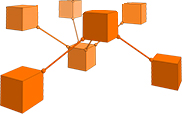
Replacing Rockwell’s RSSQL
Background
Rockwell’s RSSQL (or FactoryTalk Transaction Manager) is typically used to move data from PLCs into databases on either timed intervals (classical data collection) or events (production tracking). Additionally it can be used to download information from the database into PLCs using slightly more complex transactions.
Database connectivity options provided by RSSQL include ODBC and OLE-DB connectors. Connectivity with PLCs is accomplished either directly with Rockwell drivers such as RSLinx or RSLinx Enterprise or generic OPC drivers, which extend the connectivity of RSSQL to most PLC platforms other than Rockwell.
Many of the solutions provided by Soltus incorporate multiple business rules into the configuration, which govern the format of the data collected, a range of decision logic to be implemented for production reporting, and an expanded download process that interacts with a much broader range of target manufacturing equipment than simple PLCs (such as label printers, cameras, screwdrivers, custom processors, etc.).
Typically, when RSSQL is deployed in a manufacturing environment, HMIs are used for operator interaction and initiation of the download process. Depending on the complexity of the download process, and the inclusion of additional business components (like scheduling, interaction with MES systems such as SAP, etc.) the HMI configuration will utilize many add-on components not included with Rockwell HMI software such as RSView32 and RSViewSE.
Due to the technical skill level required, most of the changes to the overall system are made by an outside contractor and not the manufacturer’s engineering staff. This includes changes in RSSQL to change business logic implementation, RSView changes that result in expansions of the download process either due to the related systems or additional hardware interaction. Changes to the HMI by the local engineering staff tend to be infrequent once the production process has matured past the initial installation phase.
Situation
A second tier automotive manufacturer had used Rockwell hardware and software to implement flexible cellular manufacturing. Production reports were being generated from data stored in SQL Server databases by RSSQL. Product changeovers were implemented using RSView HMI stations which triggered RSSQL transactions. Additional tools had been written in Microsoft Visual Studio as add-ons to Microsoft SQL Server for downloading to and interacting with a range of cell hardware, including screwdrivers, printers, inspection cameras, third party testing equipment, and MES systems.
To guide the operator through the manufacturing process, visual instruction information was downloaded to the HMI, and an extensive set of sequencing instructions were downloaded to the local PLC responsible for enforcing quality checkpoints. Extensive use of VBA scripting within the RSView product was used to visually coordinate the display with the state of the PLC’s production sequence, including proactive prompting, error logging, context-based work instructions, and overall visual progress indicators.
Due to the tightly coupled nature of the HMI display and the operator’s movements, the responsiveness of the HMI was critical. It was discovered that the VBA scripting provided in both RSView32 and RSViewSE were not adequate to keep pace with the operator’s movements. Once an initial training phase was completed, the operators were noticeably constrained by the requirement to wait for the HMI screen to update. The delay was observed to be as great as 5 seconds for some operations.
Additionally, an annual software support fee was required for both the RSSQL product and each of the HMI products, along with the associated RSLinx drivers.
Action
The solution that was chosen consisted of a custom HMI, developed in Visual Studio 2008 using VB.NET. The functionality of the RSSQL server component was replaced by additional features implemented in the local HMI software.
At the time of the implementation, the database was upgraded to Microsoft SQL Server 2008, which provided additional reporting features and greater flexibility. Many of the additional system components, such as inspection camera programs, visual work instructions, and additional graphical prompts were moved into the database for easier management, backup, and access.
All of the server components used to interact with the additional hardware systems were moved from the database to the HMI application. Since the HMI is able to download the various data elements from the database, using the previously developed software download modules actually improved control over the download process. The entire process was now contained within the HMI, providing additional information to the operator about the progress of the cell changeover process.
Communication with the PLCs was accomplished using INGEAR toolkits. Since SLC, ControlLogix, and CompactLogix PLCs were present within a single facility, both the INGEAR.AB and INGEAR.Logix toolkits were used. After purchasing the developer toolkits, an unlimited number of runtime licenses were available for no additional cost to the customer.
By analyzing the existing set of requirements for multiple stations at multiple plants, a single HMI solution was developed that would work for a wide variety of cells. By modifying the configuration parameters for the HMI application, all of the cellular hardware was supported in all of the customer’s facilities in multiple countries.
Result
An initial test application was written for demonstration of the overall HMI functionality. Once the desired performance was proven (less than 100 msec response time), a series of projects was planned and executed to replace each type of cell. After initial training on HMI usage, the desired operator performance has been consistently reached.
Feedback from the customer indicates that there is a greater match between the functional requirement of the HMI software and the performance. Additionally the overall system has been standardized across a wide range of hardware platform configurations and manufacturing processes.
The resulting software solution has reduced support cost. Since a single version of the software can be installed and maintained in multiple plants, a greater number of local support staff can manage additional installations. Expansions to the original feature set have been accomplished over time and the cumulatively cost has been less than the previous annual Rockwell support costs.